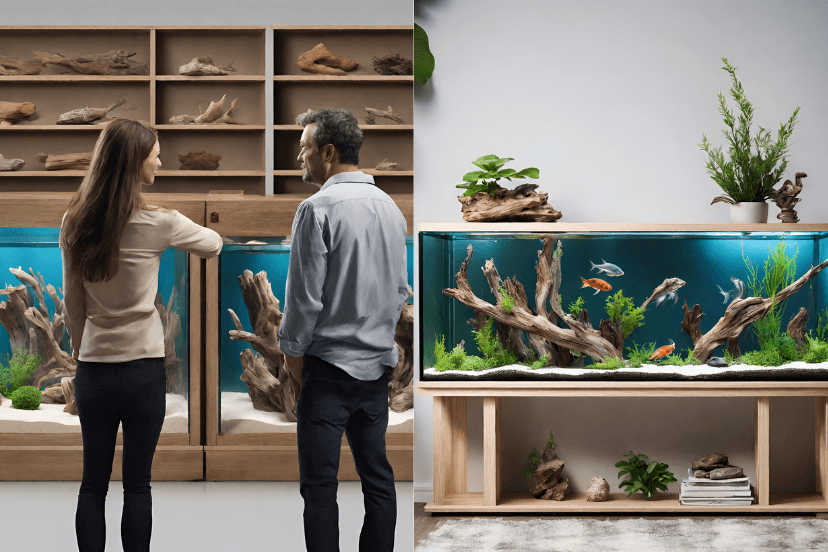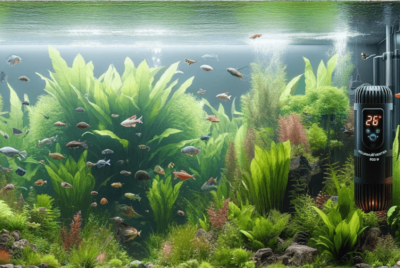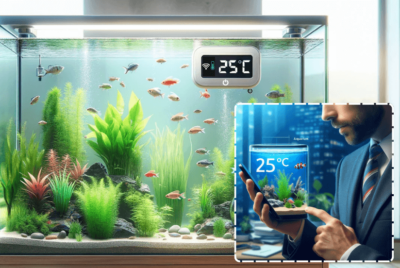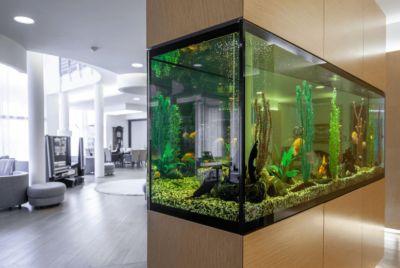Aquarium Driftwood: Its Role in Healthier Fish Tanks
Hey there, fellow aquascaping enthusiasts! Have you ever marveled at the serene beauty of a well-put-together aquarium and wondered about the secrets behind its tranquility and health benefits for the fish? One key element that often goes unnoticed but plays a vital role in aquarium driftwood. Not just a piece to beautify the tank, driftwood is a cornerstone for creating a healthier environment for our finned friends. In home and office aquariums, it adds beauty and tranquility. Let’s dive deep into how integrating driftwood with smart aquarium technology can revolutionize your aquatic setup.
Understanding Aquarium Driftwood
What is Aquarium Driftwood?
Aquarium driftwood is wood that has soaked into water bodies for long periods, experiencing natural saturation and erosion. This process ensures the wood is safe for aquarium use. Additionally, it acquires a unique, weathered look that significantly enhances tank esthetics. Such characteristics make aquarium driftwood a prized addition, elevating the visual appeal of aquatic setups, especially in large fish tanks. Driftwood serves a purpose beyond mere decoration; it plays a vital role in the aquatic ecosystem. It contributes to the tank’s chemical balance, releasing tannins that soften and gently acidify the water. This process creates conditions similar to the natural habitats of many aquatic species. Thus, driftwood is essential for replicating the environment in which these species flourish.
Types of Driftwood for Aquariums
Selecting the right type of driftwood for your aquarium is vital for achieving your desired aesthetic and ecological balance. Here are some popular choices:
Mopani Wood

Mopani Wood stands out in the aquarium landscape for its durability and complex designs. This type of wood is renowned for its ability to sink rapidly, eliminating the need for pre-soaking or weighting down, a common necessity with other driftwood types. Its distinctive, twisted forms and rich, dark tones introduce a striking, natural aesthetic to any aquarium, making it perfect for those seeking to add dramatic flair to their aquatic environments.
The quick-sinking characteristic of Mopani wood makes it an excellent choice for aquarists eager to create underwater scenes with minimal fuss. Its unique appearance not only captivates the human eye but also provides numerous hiding spots and territories for fish and invertebrates, enhancing their sense of security and well-being. Furthermore, Mopani wood’s hardiness ensures it lasts longer in the tank, offering enduring beauty and functionality. Whether you’re aiming for a rugged, natural look or a carefully sculpted aquascape, Mopani wood brings depth and drama to your aquatic setup.
Manzanita

Manzanita wood is widely celebrated among aquascaping enthusiasts for its stunning, intricate branching patterns that add a captivating visual complexity to any aquarium. Its natural beauty makes it a favorite choice for those aiming to design lush underwater forests or detailed, scenic layouts. Notably, Manzanita has a minimal impact on water chemistry, making it a safe and attractive option for a variety of aquatic setups. This feature ensures that aquascapers can focus on creativity without worrying about altering their tank’s balance. Ideal for both freshwater and marine environments, Manzanita’s versatility and aesthetic appeal make it an essential component for anyone looking to elevate their aquascaping projects.
Malaysian Driftwood

Malaysian Driftwood is highly sought after in the aquascaping community, recognized for its rich, dark color that instantly adds a layer of depth and contrast to any aquarium landscape. Its natural dark hues stand out against the bright greens of aquatic plants and the vibrant colors of fish, creating a visually striking environment. One of the key benefits of Malaysian Driftwood is its ability to sink quickly, eliminating the need for pre-soaking or weighing it down, which is often necessary with other types of driftwood. This feature makes it incredibly user-friendly, especially for enthusiasts eager to achieve a mature, established look in their tanks without delay. Perfect for thematic aquariums aiming for a mysterious or natural riverbed appearance, Malaysian Driftwood offers both aesthetic appeal and practicality, enhancing the overall ambiance of the aquatic setup.
Bogwood

Bogwood, a denser variety of driftwood, is highly valued in the aquascaping community for its distinctive properties. Its capacity to lower pH levels in aquarium water is particularly beneficial, making it an excellent choice for creating acidic conditions favored by certain fish and plant species. The release of tannins from Bogwood not only contributes to a darker, more natural-looking water but also enriches the environment, mirroring the habitats of many tropical aquatic life forms. This characteristic ambiance is ideal for species that thrive in tannin-rich waters, providing them with a setting that closely resembles their native ecosystems. As a result, Bogwood stands out as a versatile and functional addition to tanks aiming for authenticity and biological balance, enhancing both the aesthetic and health of the aquarium.
Cholla Wood:

Cholla Wood, originating from the skeletal remains of the Cholla cactus, emerges as a unique and highly beneficial addition to any shrimp tank. Renowned for its porous structure and lightweight form, it provides the ideal sanctuary for shrimp, offering numerous hiding spots that are essential for their well-being and stress reduction. Furthermore, the surface of Cholla Wood is a perfect substrate for biofilm and algae to develop, serving as a natural feeding ground for shrimp. This not only simplifies their dietary needs but also encourages natural foraging behavior, contributing to a healthier and more active shrimp population. Incorporating Cholla Wood into your aquarium not only enhances its visual appeal with its distinctive, natural look but also supports the ecological balance, making it a smart choice for hobbyists seeking to create a thriving shrimp habitat.
Every driftwood type introduces distinct traits to an aquarium, ranging from water conditioning properties to a unique visual appeal. Recognizing these variations is crucial for choosing the ideal driftwood for your aquarium’s specific requirements. By doing so, you craft an environment where the beauty and health of your aquatic ecosystem thrive together. This careful selection ensures your tank benefits fully from the natural advantages driftwood offers.
The Benefits of Driftwood in Aquariums
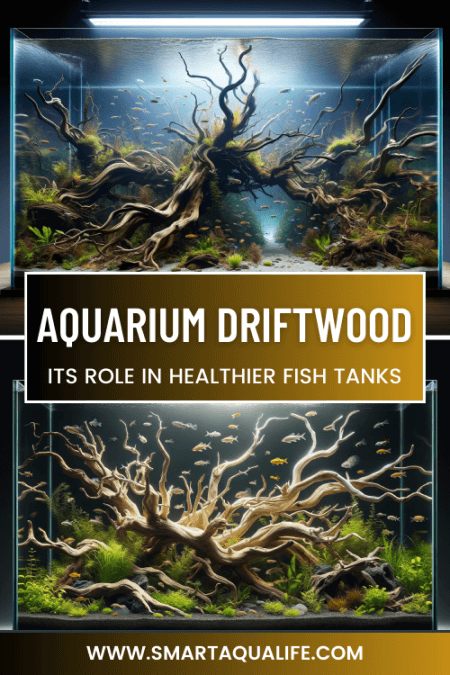
Driftwood isn’t just a piece of wood; it’s a game-changer for your aquarium. Its benefits go well beyond just looks, becoming essential for any aquatic enthusiast aiming to closely replicate their aquatic friends’ natural environment. Driftwood is a must-have, offering more than beauty to any aquarium setup.
Natural Habitat for Fish
Introducing driftwood into your aquarium does wonders for your fish. It replicates their natural habitat, offering them hiding places and territories, which can significantly reduce stress levels. Fish that nibble on wood as part of their diet gain significantly from driftwood’s presence, enhancing their natural feeding habits. This makes driftwood a multifaceted addition to your tank, serving both dietary and decorative purposes.
Water Quality Improvement
Driftwood plays a crucial role in maintaining the water quality of your aquarium. It releases tannins that can lower the pH to more natural, acidic levels, beneficial for many fish species. These tannins also have antibacterial properties that help in fighting off potential infections, ensuring a healthier environment for your aquatic life.
Aesthetic Appeal in Aquascaping
Driftwood contributes significantly to the aesthetic appeal of aquascaping, offering a diverse array of shapes and textures to enhance underwater landscapes. Whether you’re envisioning a dense jungle or a minimalist design, driftwood provides the versatility required to realize your aquascaping dreams. Transitioning to aquarium rocks, these natural elements serve as complementary features alongside driftwood, adding to the visual richness of your aquarium setup.
Aquarium rocks not only enhance the aesthetic appeal of your aquascape but also serve functional purposes. They offer hiding spots and shelter for fish, promoting their well-being and reducing stress levels. Additionally, aquarium rocks can anchor plants and prevent soil erosion, contributing to the overall stability and sustainability of your aquatic ecosystem. When combined with driftwood, aquarium rocks create a harmonious underwater environment that both captivates the eye and supports the health of your aquatic inhabitants.
Integrating Driftwood with Smart Aquarium Technology
Combining driftwood with smart aquarium technology elevates your tank’s health and beauty, making maintenance both efficient and effective.
Monitoring Water Parameters
Smart aquarium systems can monitor water parameters in real-time, alerting you to any changes that driftwood might cause in your tank’s chemistry. This allows for immediate adjustments, ensuring the driftwood benefits your aquarium without negatively impacting the water quality.
Automating Driftwood Care
With the advent of smart aquarium technology, caring for your driftwood has never been easier. Automated systems can adjust lighting to highlight its natural beauty and control filtration to manage the tannins released, ensuring your aquarium remains a healthy and visually stunning ecosystem. Integrating driftwood with smart technology not only simplifies maintenance but enhances the overall well-being of your aquatic environment.
Selecting the Right Driftwood for Your Smart Aquarium
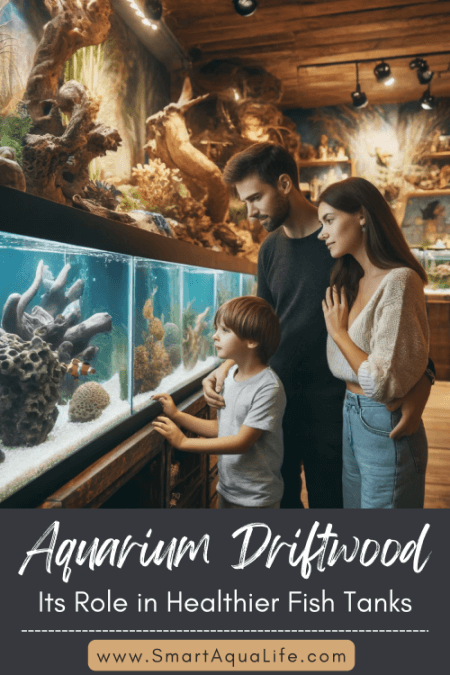
Choosing the perfect piece of driftwood is more than picking the most appealing log. It’s about finding a piece that complements your aquarium’s ecosystem, benefiting both the inhabitants and the overall aesthetics.
Compatibility with Fish and Plants
Not all driftwood is suitable for every aquarium. Some types of wood may affect water chemistry more drastically than others. Softwoods, for instance, can decompose quickly, altering water parameters. Opt for hardwoods that are safe for both fish and plants, and consider the size and shape of the driftwood to ensure it fits well in your tank without overcrowding it.
Preparing Driftwood for the Aquarium
Before adding driftwood to your aquarium, it’s crucial to prepare it properly to avoid any negative impact on your tank’s environment. Boiling the driftwood helps remove tannins that discolor the water and kills any bacteria or parasites present. Soaking it afterward for one to two weeks, changing the water daily, will further leach tannins and ensure the wood is fully waterlogged and ready to sink.
Maintenance and Care for Driftwood
Regular maintenance is key to ensuring your driftwood remains a beneficial addition to your aquarium without causing any unwanted changes to the tank’s ecosystem.
Cleaning and Maintenance Tips
Over time, driftwood may accumulate algae or biofilm. Gently scrubbing the wood with a soft brush in dechlorinated water can remove unwanted growths without harming the wood’s surface. Avoid using soaps or detergents, as these can be toxic to your aquarium’s inhabitants.
Monitoring Decomposition and Effects on Water
The gradual decomposition of driftwood is a natural process that impacts the water quality within aquariums. However, the advancement of smart aquarium technology offers a groundbreaking solution to this challenge. Innovative devices now track essential water parameters like pH levels and hardness, revolutionizing aquarium maintenance. They offer real-time alerts for any changes in water quality that could be caused by driftwood. This immediate feedback allows for quick and efficient corrective actions. As a result, managing the impact of driftwood on your aquarium’s ecosystem has never been easier.
Furthermore, the importance of regular inspections cannot be overstated. By closely monitoring the driftwood for signs of excessive decay, aquarium enthusiasts can pinpoint the best time for its replacement. This vigilant strategy is crucial for maintaining high water quality. Moreover, it plays a significant role in safeguarding the health and visual allure of your smart aquarium. Adopting this proactive approach ensures your aquatic environment remains both beautiful and thriving. As we continue to embrace these technological advancements, the synergy between natural elements and digital monitoring tools heralds a new era in aquarium care, blending beauty with efficiency.
Common Challenges and Solutions
While driftwood can be a fantastic addition to any aquarium, it’s not without its challenges. Here are some common issues aquarium enthusiasts might face and how to address them.
Algae Growth on Driftwood
Algae growth on driftwood is a natural occurrence but can become unsightly if left unchecked. The key to managing algae is maintaining a balanced tank environment. Reducing light exposure, ensuring proper nutrient levels, and introducing algae-eating fish or invertebrates can help control algae growth. For stubborn algae, gently scrubbing the driftwood with a soft brush in tank water during regular maintenance should keep it at bay.
Adjusting Water Parameters
Driftwood can alter water parameters by releasing tannins, softening water, and lowering pH levels. While beneficial for many species, these changes might not suit all aquarium inhabitants. Using smart aquarium technology to monitor water parameters closely allows for timely adjustments. If driftwood significantly impacts water chemistry, consider pre-soaking it longer to reduce tannin release or using water conditioners to stabilize the environment. Balancing the ecosystem ensures that both your driftwood and aquatic life can coexist harmoniously.
Future of Driftwood in Smart Aquariums
The integration of driftwood in aquariums is experiencing a thrilling evolution, propelled by advancements in smart technology and a deep dedication to sustainability. Looking ahead, the significance of aquarium driftwood in enhancing the health and visual charm of aquariums is set to increase. This shift promises to elevate the natural beauty and ecological balance within tanks. As a result, driftwood’s contribution to both the aesthetic and health aspects of aquariums will become even more pivotal.This expansion is fueled by a wave of innovative design choices and eco-conscious practices. Furthermore, blending natural elements with advanced technology not only simplifies aquarium upkeep but also fosters dynamic, self-regulating ecosystems. This synergy promises a future where aquarium care becomes more intuitive and less time-consuming. In this evolving landscape, driftwood transcends its traditional role, becoming a cornerstone of modern aquascaping. It supports environments where aquatic life thrives, surrounded by beauty and equilibrium.
Innovations in Aquarium Design
The future of aquarium design is smart and natural, with driftwood playing a central role. Advanced smart aquarium systems will revolutionize the care of aquatic environments by automating water parameter monitoring and adjustments. They will also intelligently control lighting to showcase each piece of driftwood’s unique features. Picture LED systems designed to mimic natural light cycles or seasonal shifts, highlighting the textures and shapes of the driftwood. This technology will create dynamic, evolving underwater landscapes that captivate and enchant viewers.
Sustainable Sourcing of Driftwood
As the aquarium hobby continues to grow, so does the importance of sourcing driftwood sustainably. The future will highlight the importance of ethically harvested driftwood, promoting the conservation of natural waterways and forests. This shift ensures that our aquarium hobby aids in preserving the environment. Innovations in traceability and certification will empower aquarists to make informed decisions. By selecting driftwood thoughtfully, enthusiasts can enhance their tanks’ beauty while supporting natural habitat conservation.
Conclusion
Integrating driftwood into your aquarium setup introduces a wealth of benefits, significantly enhancing water quality and mimicking the natural habitats of your aquatic friends. This natural element, when paired with the latest advancements in smart aquarium technology, opens up a realm of possibilities for creative and effective aquascaping. Experimentation with various types of driftwood not only becomes a rewarding adventure for aquarists of all levels but also a journey into understanding the nuanced impacts these pieces can have on the ecosystem within your tank.
The ecological and aesthetic advantages of incorporating driftwood are undeniable. Driftwood plays a crucial role in conditioning water and providing refuge for aquatic life. It supports the overall health of your aquarium inhabitants, making it indispensable for a thriving setup. As you embrace the natural charm and functionality of driftwood, let it be the cornerstone of your next aquascaping project. Transform your aquarium into a vibrant, thriving underwater oasis that captivates and delights with the inclusion of driftwood.
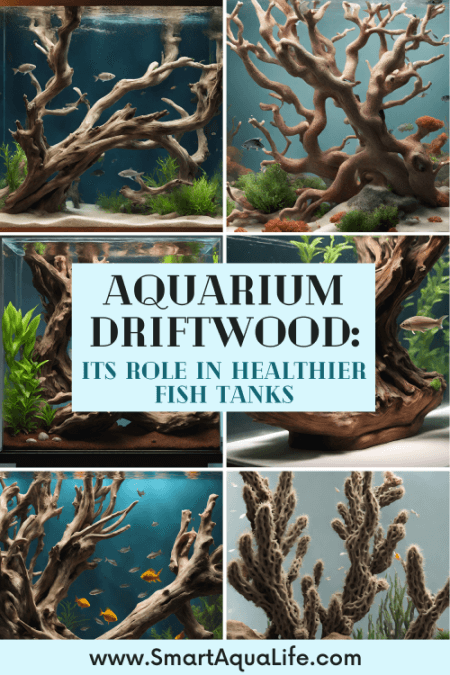
FAQs
Diving into the world of aquarium driftwood brings up many questions. Let’s address some of the most frequently asked questions to help you enhance your aquarium with driftwood confidently.
Q: How do I choose the right driftwood?
A: When selecting the right driftwood, consider the size of your aquarium, water parameters, and the types of fish and plants you’re housing. These factors ensure optimal compatibility and create a thriving aquatic environment. Look for pieces that fit the scale of your tank without overcrowding it. Hardwoods are generally preferred for their durability and less impactful tannin release.
Q: How often should driftwood be replaced?
A: The longevity of driftwood in an aquarium varies based on its type and the tank conditions. There’s no fixed timetable for replacing driftwood; it’s essential to keep an eye on it for signs of significant decay. If it begins to break down excessively, this could impact your water quality. On average, a quality piece of driftwood can last several years before needing replacement.
Q: Can driftwood affect the pH of my aquarium?
A: Driftwood can indeed lower your aquarium’s pH by releasing tannic acids. This effect is advantageous for numerous tropical and freshwater fish species that prefer slightly acidic conditions. The extent of pH change depends on the driftwood’s size and the water volume. Additionally, the initial chemistry of the water plays a critical role in this process.
Q: Is driftwood suitable for all types of fish?
A: Many freshwater fish, particularly those from river and lake habitats with natural wood, thrive with the addition of driftwood. However, certain marine and alkaline water species may not benefit as much from it. Research your specific fish species’ natural habitats and preferences to determine if driftwood is a suitable addition.
Q: How can smart technology enhance the benefits of aquarium driftwood?
A: Smart aquarium technology dramatically boosts the advantages of using driftwood in your tank. It monitors water parameters in real-time, enabling swift adjustments to keep conditions ideal. Automated systems also tweak lighting to accentuate the driftwood’s natural beauty. Plus, they promptly notify you of any critical shifts in water chemistry, guaranteeing the driftwood continually benefits your aquarium’s ecosystem.

